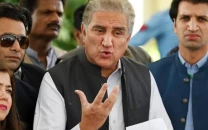6% GDP target next FY unlikely
Finance ministry says growth rate may remain at 5% due to financial pressures

The federal government's Annual Plan Coordination Committee (APCC) has set a growth target of 5% for the next financial year. In the current fiscal year, the economic growth rate is expected to be up to 6%.
Earlier, the finance ministry had warned that the country's overall economic growth would not grow at 6% in the next financial year. According to a report published in BBC Urdu, the finance ministry’s prediction and the APCC’s target of 5% came at a time when the new government in the country is just about two months old and will present its first budget.
The growth target set by the APCC at 5% and the finance ministry’s prediction that the overall economic growth rate will not grow at the rate of 6% in the next financial year is based on data released by the government's national accounts committee.
The committee said that in the current financial year, the GDP growth rate would remain at 6%.
The finance ministry has attributed the slowdown in the GDP growth in the next financial year to the spiralling inflation and depreciation of the local currency against the US dollar.
The ministry said although the country's economy was expected to grow at a rate of 6% in the current financial year, the growth could not be sustained in the next fiscal year due to financial pressures and the performance of the external sector.
Economists have said the finance ministry’s prediction meant that the country’s economy was “overheated” -- meaning that it was growing beyond its capacity and not sustainable. According to them, this country’s economy was one in which there was more consumption than production.
READ Economy may not sustain 6% growth in FY23
In their opinion, this “over-consumption” fuelled inflation and was dangerous for the economy. Although increasing the country's economic growth rate is necessary to create new jobs, it also creates problems for a country that relies on imports for energy and raw materials for industry.
Minister of State for Finance Dr Ayesha Ghous Pasha, while commenting on the economic growth figures of the previous government, said it was debt- and consumption-led growth, which was not sustainable.
However, Muzammil Aslam, the spokesperson for the PTI’s economic affairs, credited his government’s policies for the growth rate this financial year. “The GDP growth this year is due to the growth in agricultural and industrial sectors. This growth is based on production,” he added.
Aslam further said the current government believed that the economic growth rate would not be maintained at 6% in the next financial year because of high interest rates and its inability to meet energy needs. “It is these factors that make an increase in the growth rate in the next fiscal year unlikely.”
A report released by the finance ministry read that because of the micro-economic imbalance in the country, it was difficult to achieve 6% economic growth next year. According to the ministry, the country was currently facing rising inflation, foreign trade deficit, falling value of the national currency, rapidly declining foreign exchange reserves and growing uncertainty.
It should be noted that in the last year of the PML-N government which ended in 2018, the economic growth rate was more than 6%. However, after the formation of the PTI government, the GDP growth slowed down. In the second year of the PTI government the rate went down to negative because of the Covid-19 outbreak.
Last year, the growth was close to 4%. This year, the economic growth rate is expected to be 6%.
Elaborating on the situation, Shahid Mahmood, a research fellow at the Pakistan Institute of Development Economics and an expert in economic affairs, said whenever the pace of economic growth of the country increased, the demand for energy hiked as well.
“Pakistan depends on external sources for energy needs including oil, gas and coal,” he added.
He further explained that when the demand for energy increased, putting pressure on the country's import bill. “External payments, which require US dollars, will also increase. When the dollar is spent, it will put pressure on the country's foreign exchange as well affect the value of the local currency.”



















COMMENTS
Comments are moderated and generally will be posted if they are on-topic and not abusive.
For more information, please see our Comments FAQ